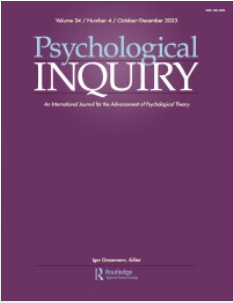Complex, Dynamic, & Internal: As Simple As Possible, But No Simpler Than That
IF 4.1
2区 心理学
Q1 PSYCHOLOGY, MULTIDISCIPLINARY
引用次数: 0
Abstract
Abstract In response to the Attention to Thoughts (A2T) model, scholars reflected on and raised critical questions about the proposed complex dynamic systems theory, its computational formalization, and its implications for theory and study of internal attention and internally-directed cognition (IDC). We identify and reflect on three major themes that cut across these response papers related to, complexity, temporal dynamics, and internal states as a focus of scientific inquiry. (1) As Simple As Possible, But No Simpler: Necessary Complexity. We delineate the importance of developing formalized and dynamic systems theory to model behavioral complexity in IDC. Specifically, behavioral variations or processes which exhibit a range of trajectories and states of variable levels of temporal stability, that emerge from reciprocal and (often) non-linear interactions between attentional, mnemonic and affective processes, that unfold over time and context. (2) Complex Dynamical Systems Emerge in Time . We reflect on the observation that temporal trajectories, that self-organize into relatively stable patterns, across time-scales, emerge from moment-to-moment interactions within the system over micro time-scales; and that through circular causality that facilitates systemic self-regulation, emergent higher-level structures or macro time-scale trajectories function to constrain these moment-to-moment interactions within the system. In turn, we relate to future developments of A2T to model developmental, learning and plasticity processes in IDC that emerge over macro time-scales. (3) The Elephant in the Lab: Is Robust Scientific Theory and Study of Internal States Possible? We reflect on the conditions wherein external attention is, and is not, likely a meaningful proxy for internal attention, and the implications therein for the study of attention in mental health and related phenomena sub-served by IDC. Finally, we relate to future developments of A2T that could reflect theorized computational heterogeneity in objects competing for internal attentional selection.复杂、动态和内部:尽可能简单,但不比这更简单
摘要针对注意力-思想(A2T)模型,学者们对所提出的复杂动态系统理论、其计算形式化及其对内部注意力和内部定向认知(IDC)理论和研究的启示进行了反思并提出了关键问题。我们确定并反思了贯穿这些回应论文的三个主要主题,即复杂性、时间动态和作为科学研究重点的内部状态。(1) 尽可能简单,但不简单:必要的复杂性。我们阐述了开发形式化和动态系统理论对IDC中行为复杂性建模的重要性。具体而言,行为变化或过程表现出一系列时间稳定性的轨迹和状态,这些变化或过程源于注意力、记忆和情感过程之间的相互和(通常)非线性互动,随着时间和环境的推移而展开。(2) 复杂动力系统在时间中出现。我们反思了这样一个观察结果,即时间轨迹在时间尺度上自组织成相对稳定的模式,在微观时间尺度上从系统内的时刻到时刻的相互作用中出现;通过促进系统自我调节的循环因果关系,新兴的更高层次结构或宏观时间尺度轨迹起到了约束系统内这些瞬间互动的作用。反过来,我们将A2T的未来发展与IDC中在宏观时间尺度上出现的发展、学习和可塑性过程建模联系起来。(3) 实验室里的大象:稳健的科学理论和内部状态研究可能吗?我们反思了外部注意力可能是,也不可能是内部注意力的有意义的替代品的条件,以及其中对IDC研究心理健康中的注意力和相关现象的影响。最后,我们讨论了A2T的未来发展,它可以反映竞争内部注意力选择的对象的理论计算异质性。
本文章由计算机程序翻译,如有差异,请以英文原文为准。
求助全文
约1分钟内获得全文
求助全文
来源期刊

Psychological Inquiry
PSYCHOLOGY, MULTIDISCIPLINARY-
CiteScore
10.30
自引率
1.10%
发文量
31
期刊介绍:
Psychological Inquiry serves as an international journal dedicated to the advancement of psychological theory. Each edition features an extensive target article exploring a controversial or provocative topic, accompanied by peer commentaries and a response from the target author(s). Proposals for target articles must be submitted using the Target Article Proposal Form, and only approved proposals undergo peer review by at least three reviewers. Authors are invited to submit their full articles after the proposal has received approval from the Editor.
 求助内容:
求助内容: 应助结果提醒方式:
应助结果提醒方式:


